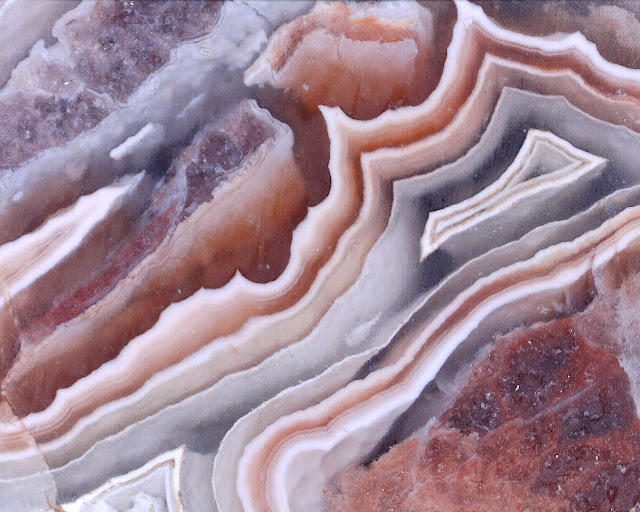From the "just because" file:
Macro photos of a slice of rock picked up in a local antique shop. The rock, at least, is antique; the slicing and polishing probably not.
 |
| Looks like walls of a maze |
 |
| Trying to imagine what processes would make these patterns |
 |
| Tubes in bubbles |
Again, just because. I can't give a name to this piece of stone; I don't know where it originated, but it intrigues me.
UPDATE: from a comment by Peter Allen in Geology of Vancouver Island (Facebook).
Agate. Silica deposited from an aqueous solution, the lines represent changes in concentration of the solution. The solution was under high temperatures and pressures.
AND UPDATE #2: From a link on the previous comment: Origin..., pg. 19.
As explained above, the mechanism of agate growth is still a mystery to scientists. ... Agates represent one of the most impressive examples of spontaneous pattern generation in the world, and studying agate crystal growth could help explain how natural patterns like these are generated without an external template. Agates are a noteworthy case of self-organization, both texturally and compositionally, and their origin has far-reaching geochemical, crystal-growth, and petrologic implications.
~~~~~~~~~~~~~~~~~~~~~~~~~~
Del archivo llamado "porque sí": fotos macro de una rebanada de piedra que compré en una tienda de antigüedades. La piedra es antigua; dudo que lo es el trabajo de rebanar y pulir.
Porque sí. No puedo identificar este tipo de piedra. No sé de donde vino, pero me inspira curiosidad.
ACTUALIZANDO: de un comentario por Peter Allen en la página Facebook, Geology of Vancouver Island.
Agata. Sílice depositado desde una solución acuática; las lineas muestran cambios de la concentración de la solución. La solución estaba bajo temperaturas y presiones altas.
Y ACTUALIZANDO UNA VEZ MAS: de un enlace en el comentario citado:
Como se explica arriba, el mecanismo del crecimiento de $gatas sigue siendo un misterio para los científicos. ... Las ágatas son uno de los ejemplos más impresionantes del origen espontáneo de modelo mundiales, y estudiar el crecimiento de los cristales puede ayudar a explicar como es que modelos naturales como estos se generan sin una esquema exterior. Las ágatas son un ejemplo notable de organización autónoma, tanto en su textura como en la composición, y su origen lleva consecuencias importantes en los campos de geoquíica, crecimiento de cristales, y petrológicos.

No comments:
Post a Comment
I'm having to moderate all comments because Blogger seems to have a problem notifying me. Sorry about that. I will review them several times daily, though, until this issue is fixed.
Also, I have word verification on, because I found out that not only do I get spam without it, but it gets passed on to anyone commenting in that thread. Not cool!